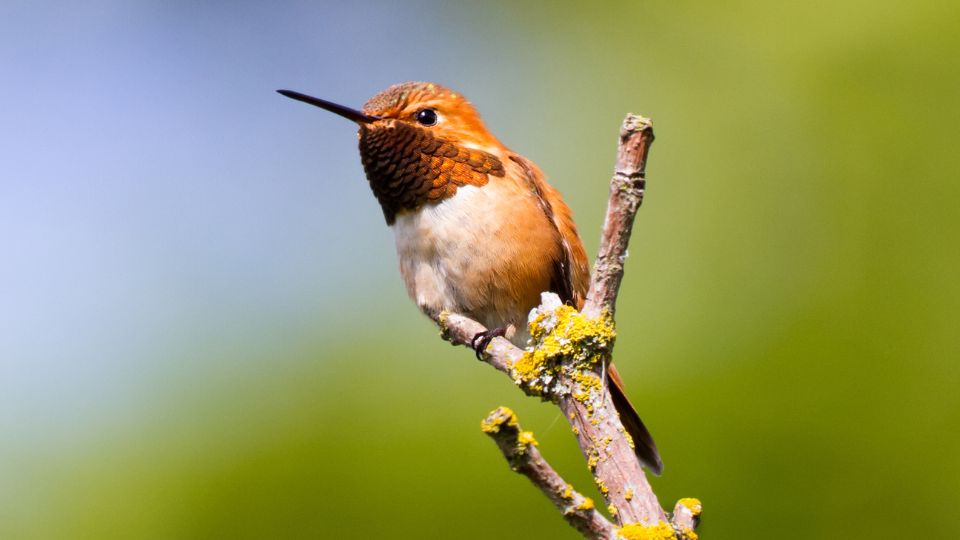Wisconsin is home to 8 types of hummingbirds, 1 of which is somewhat regular — The Ruby-throated hummingbird. Rufous is considered near-threatened in this state, and the other 6 are accidental visitors. Keep your feeders out from April to September since this is the hummingbird season in the state.
Hummingbirds are considered a regular occurrence during summer in Wisconsin. You might see Ruby-throated, Rufous, Allen’s, Anna, and many other hummingbirds. If you plan on attracting more of them to your yard, start setting out feeders in early April. Wait until the hummingbird migration in September to take them down, as that’s when the fall migration happens.
So far, there have been eight types of hummingbirds in Wisconsin, with 1 recognized as Wisconsin’s regular visitor. A total of 6 are considered accidental, and one is near-threatened. This list will help you identify hummingbirds you might see around Wisconsin. You’ll also learn how to attract more hummingbirds to your yard. Keep reading to see when the hummingbird season starts in this state.
Table of Contents
What Kind of Hummingbirds Come to Wisconsin?
Currently, a total of eight species of hummingbirds have been reported in Wisconsin. One of these is recognized as a seasonal visitor. The other 6 are rare or accidental visitors, and the last one is considered near-threatened in this area. This data is based on the birdwatchers’ lists and banding data from expert websites.
What Is the Most Common Type of Hummingbird in Wisconsin?
The Ruby-throated hummingbird is the most common kind of hummingbird around Wisconsin. They appear on 14% of birdwatching checklists submitted by the states birdwatchers. Their peak season when they are most active is the end of May. They’ll love visiting your bird feeders, drinking some sugar water, then buzzing around for additional food sources.
On the other hand, these are the least common kinds of hummingbirds seen in Wisconsin:
- Rufous Hummingbird
- Allen’s Hummingbird
- Anna’s Hummingbird
- Green-breasted Mango
- Broad-billed Hummingbird
- Mexican Violetear
- Buff-bellied Hummingbird

Ruby-throated Hummingbird
Ruby-throated Hummingbird (Archilochus colubris) appears in 14% of checklists submitted by birdwatchers in the state. Wisconsin is their breeding ground, so you can expect to see them around from April to October.
The size of an adult Ruby-throated is around 3 inches. Adult male Ruby-throated hummingbirds have red throats (gorgets) that look black in poor light. Their chin strap will help you differentiate it from Broad-tailed hummers. Males also have iridescent green backs, white underparts, and grayish-greenish sides. Adult females come with a metallic green back, white throat, and gray-brown sides.
This is the only hummingbird with breeding grounds east of the Mississippi River in the eastern US. They’re also present in eastern Texas, Oklahoma, Minnesota, and southern Canada.
Their winter range includes South Florida and the Gulf of Mexico. Sweet nectar is their favorite food. They also get protein from small insects they steal from spider webs. These hummers have short legs, so they barely walk. Instead, you’ll see them resting on branches.

Rufous Hummingbird
Rufous Hummingbird (Selasphorus Rufus) is marked as a near-threatened kind. Still, there were some reported sightings during fall and winter along Lake Michigan, Madison, and Milwaukee. With a maximum length of 3.5 inches, they’re the longest migrating birds relative to their size.
Adult males come with reddish-brown backs, a bit darker wings, and dark orange gorgets. Adult females have greenish backs, brownish sides, and red spots on their throats, together with brownish tails. Rufous’ breeding range includes Southern Alaska, Washington, Oregon, western Montana, and northern Idaho. During the winter, Rufous visits most of Mexico and the Gulf Coast.
They feed mainly on tubular flowers’ nectars but happily accept hummingbird feeders. Their ideal habitats are mountain meadows and coniferous forests. The rufous hummingbird is super aggressive and will chase off larger predators and other hummingbirds.

Allen’s Hummingbird
Allen’s hummingbird is considered a vagrant in Wisconsin. Still, there were some reported sightings in New Glarus in 2020. They look like Rufous hummers, the only distinction being their narrow outer tail feathers. They’re also a bit larger than the Ruby-throated hummer.
Adult males have orange-red gorgets, greenbacks, and brown sides. Adult females have red tails, greenish backs, and reddish-brown flanks. This kind spends winters in Mexico and migrates to Pacific Coast in California and Oregon around January. Some spend all year in Mexico and Los Angeles.
Anna’s Hummingbird
Anna’s hummingbird (calypte anna) belongs to Wisconsin’s accidental species of hummingbirds. There were some reports of sightings around Oshkosh, Madison, and Milwaukee in the last ten years.
This hummingbird is mostly green and gray, looking like Costa’s hummers, with a slight difference in the length of throat feathers. Adult males have rose heads, but females aren’t that colorful. Still, females have some reddish feathers on their throats and greenish underparts.
Anna’s breeding range is around: Washington, Oregon, California, and Arizona. Anna’s hummingbirds spend winter on the Pacific Coast, northwest Mexico, and Arizona. They like the nectar of various plants but will also feast upon small insects. You can recognize them by their tail feathers’ sound while diving.
Green-breasted Mango
The green-breasted mango hummingbird is accidental in the state. Still, some reported seeing it in Beloit in 2007. Adults are the size of 4.3 to 4.7 inches. Males have a black chin that borders with blue on the chest. Females have whitish underparts and a black stripe in the middle. They also have a few blue metallic feathers.
Green-breasted Mangoes are super rare in all of North America. They’ll mostly be found around Mexico, Central America, and South America. This kind prefers clearings, deciduous forests, and lightly wooded areas.
Broad-billed Hummingbird
Broad-billed hummers (Cynanthus Latirostris) are another accidental species in Wisconsin, with one reported spot in Thiensville in 2011. They’re the size of about 3.9 inches. Adult males have rich metallic green bodies with blue throats. Adult females have pale throats and some bronze-green parts on their undersides. This hummingbird is a Mexican native and will also visit southern Arizona and southwestern New Mexico. Broad-billed hummers will spend winter in northwestern Mexico.
Mexican Violetear (Green Violetear)
Mexican Violetear (Colibri thalassinus) is a rare, accidental species in Wisconsin. There were some reported sightings near Gay Mills and Fairview in 2020. Their length ranges from 3.8 to 4.7 inches. Adult males have metallic green bodies with some bluish sections on the side of their heads.
Their breeding grounds include Mexican forests, some parts of Central America, Nicaragua, Bolivia, and Venezuela. Some non-breeding Violetears might get into the US, reaching southern Texas.
Buff-bellied Hummingbird
According to the latest records, Buff-bellied hummers were spotted in Wisconsin in 2017. Their size is around 3.9 to 4.3 inches. Adult males have reddish beaks with a dark tip. Adult females have darker bills. Their breeding ground is around southern Texas and the Yucatan peninsula. This hummingbird will typically spend winters on the Gulf Coast, reaching Louisiana and Florida. When they hit the US, they’ll gladly visit the nectar feeders, but their ideal habitats are around woodland edges.
How to Attract More Hummingbirds?
If you wish to attract more of these natural pollinators, consider arranging some native plants in your garden. Tubular flowers are the best option, as many hummingbirds love them. Additionally, you can purchase nectar feeders from Amazon and provide additional food sources to your tiny guests.
Include a bird bath in your garden, and remember to avoid the use of pesticides. You’ll keep the tiny insects healthy, making them an ideal protein source for baby and adult hummers. Continue to clean the feeders and restock the hummingbird nectar regularly to keep the hummers healthy and happy.
Ensure that hummingbirds are safe by avoiding using pesticides in your yard, and you’ll have guests visit you every year.

